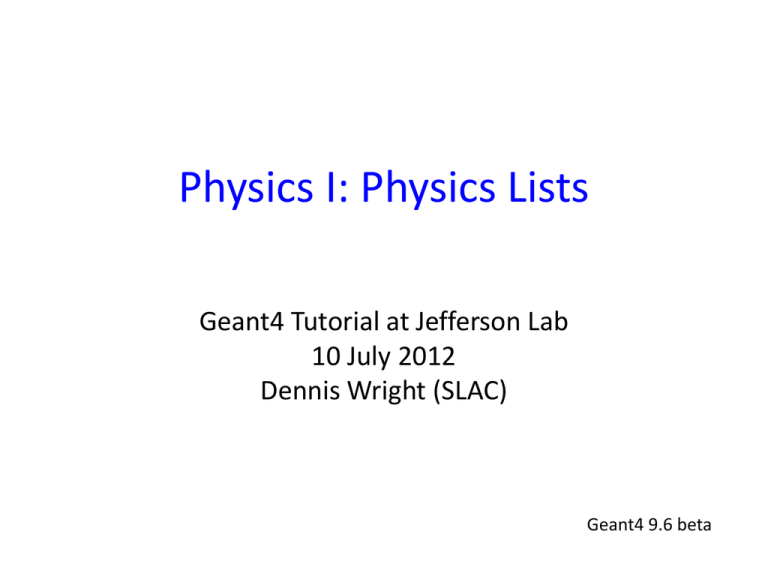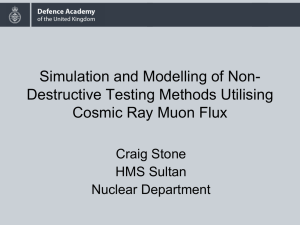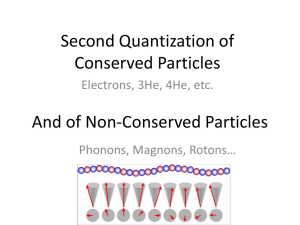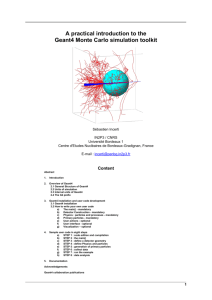Physics I: Physics Lists
advertisement

Physics I: Physics Lists
Geant4 Tutorial at Jefferson Lab
10 July 2012
Dennis Wright (SLAC)
Geant4 9.6 beta
Outline
• Introduction
– what is a physics list and why do we need one?
• The G4VUserPhysicsList class
– what you need to begin
• Modular physics lists
– a more sophisticated way to go
• Pre-packaged physics lists
2
What is a Physics List?
• A class which collects all the particles, physics processes and
production thresholds needed for your application
• It tells the run manager how and when to invoke physics
• It is a very flexible way to build a physics environment
– user can pick the particles he wants
– user can pick the physics to assign to each particle
• But, user must have a good understanding of the physics
required
– omission of particles or physics could cause errors or poor
simulation
3
Why Do We Need a Physics List?
• Physics is physics – shouldn’t Geant4 provide, as a default, a
complete set of physics processes that everyone can use?
• No:
– there are many different physics models and approximations
– very much the case for hadronic physics
– but also true for electromagnetic physics
– computation speed is an issue
– a user may want a less-detailed, but faster approximation
– no application requires all the physics and particles that Geant4
has to offer
– e.g., most medical applications do not want multi-GeV physics
4
Why Do We Need a Physics List?
• For this reason Geant4 takes an atomistic, rather than an
integral approach to physics
– provide many physics components (processes) which are
decoupled from one another (for the most part)
– user selects these components in custom-designed physics lists
in much the same way as a detector geometry is built
• Exceptions
– a few electromagnetic processes must be used together
– future processes involving interference of electromagnetic and
strong interactions may require coupling as well
5
Physics Processes Provided by Geant4
• EM physics
– “standard” processes valid from ~ 1 keV to ~PeV
– “low energy” valid from 250 eV to ~PeV
– optical photons
• Weak interaction physics
– decay of subatomic particles
– radioactive decay of nuclei
• Hadronic physics
– pure strong interaction physics valid from 0 to ~TeV
– electro- and gamma-nuclear valid from 10 MeV to ~TeV
• Parameterized or “fast simulation” physics
6
G4VUserPhysicsList
• All physics lists must derive from this class
– and then be registered with the run manager
• Example:
class BeamTestPhysicsList: public G4VUserPhysicsList {
public:
BeamTestPhysicsList();
~BeamTestPhysicsList();
void ConstructParticle();
void ConstructProcess();
void SetCuts();
}
• User must implement the methods ConstructParticle,
ConstructProcess and SetCuts
7
G4VUserPhysicsList: Required Methods
• ConstructParticle() – choose the particles you need in your
simulation and define them all here
• ConstructProcess() – for each particle, assign all the physics
processes important in your simulation
• What’s a process?
• a class that defines how a particle should interact with
matter (it’s where the physics is!)
• more on this later
• SetCuts() – set the range cuts for secondary production
– What’s a range cut?
– essentially a low energy limit on particle production
– more on this later
8
ConstructParticle()
void BeamTestPhysicsList::ConstructParticle() {
G4BaryonConstructor* baryonConstructor =
new G4BaryonConstructor();
baryonConstructor->ConstructParticle();
delete baryonConstructor;
G4BosonConstructor* bosonConstructor =
new G4BosonConstructor();
bosonConstructor->ConstructParticle();
delete bosonConstructor;
…
…
}
9
ConstructParticle() (alternate)
void BeamTestPhysicsList::ConstructParticle()
{
G4Electron::ElectronDefinition();
G4Proton::ProtonDefinition();
G4Neutron::NeutronDefinition();
G4Gamma::GammaDefinition();
…
…
}
10
ConstructProcess()
void BeamTestPhysicsList::ConstructProcess() {
AddTransportation();
// method provided by G4VUserPhysicsList assigns transportation
// process to all particles defined in ConstructParticle()
ConstructEM();
// method may be defined by user (for convenience)
// put electromagnetic physics here
ConstructGeneral();
// method may be defined by user to hold all other processes
}
11
ConstructEM()
void BeamTestPhysicsList::ConstructEM() {
G4PhysicsListHelper* ph = G4PhysicsListHelper::GetPhysicsListHelper();
theParticleIterator->reset();
while( (*theParticleIterator)() ) {
G4ParticleDefinition* particle = theParticleIterator->value();
if (particle == G4Gamma::Gamma() ) {
ph->RegisterProcess(new G4GammaConversion(), particle);
…. // add more processes
}
… // do electrons, positrons, etc.
}
12
ConstructGeneral()
void BeamTestPhysicsList::ConstructGeneral() {
G4PhysicsListHelper* ph = G4PhysicsListHelper::GetPhysicsListHelper();
// Add decay process
G4Decay* theDecayProcess = new G4Decay();
theParticleIterator->reset();
while( (*theParticleIterator)() ) {
G4ParticleDefinition* particle = theParticleIterator->value();
if (theDecayProcess->IsApplicable(*particle) ) {
ph->RegisterProcess(theDecayProcess, particle);
}
}
// Add other physics
13
SetCuts()
void BeamTestPhysicsList::SetCuts()
{
defaultCutValue = 0.7*mm;
SetCutValue(defaultCutValue, “gamma”);
SetCutValue(defaultCutValue, “e-”);
SetCutValue(defaultCutValue, “e+”);
SetCutValue(defaultCutValue, “proton”);
//
// These are all the production cuts you need to set
// - not required for any other particle
}
14
G4VModularPhysicsList
• The physics list in our example is quite simple
• A realistic physics list is likely to have many more physics
processes
– such a list can become quite long, complicated and hard to
maintain
– try a modular physics list instead
• Features of G4VModularPhysicsList
– derived from G4VUserPhysicsList
– AddTransportation() automatically called for all registered particles
– allows you to define “physics modules”: EM physics, hadronic
physics, optical physics, etc.
15
A Simple G4VModularPhysicsList
• Constructor:
MyModPhysList::MyModPhysList(): G4VModularPhysicsList() {
defaultCutValue = 0.7*mm;
RegisterPhysics(new ProtonPhysics() );
// all physics processes having to do with protons
RegisterPhysics(new ElectronPhysics() );
// all physics processes having to do with electrons
RegisterPhysics(new DecayPhysics() );
// physics of unstable particles
}
• SetCuts:
void MyModPhysList::SetCuts() { SetCutsWithDefault(); }
16
Physics Constructors
• Allows you to group particle and process construction
according to physics domains
• class ProtonPhysics : public G4VPhysicsConstructor
{
public:
ProtonPhysics(const G4String& name = “proton”);
virtual ~ProtonPhysics();
virtual void ConstructParticle()
// easy – only one particle to build in this case
virtual void ConstructProcess();
// put here all the processes a proton can have
}
17
Pre-packaged Physics Lists
• Our example dealt mainly with electromagnetic physics
• A complete and realistic EM physics list can be found in novice
example N03
– a good starting point
– add to it according to your needs
• Adding hadronic physics is more involved
– for any one hadronic process, user may choose from several
hadronic models
– choosing the right models for your application requires care
– to make things easier, pre-packaged physics lists are provided
according to some reference use cases
18
Pre-packaged Physics Lists
• Each pre-packaged physics list includes different choices of
EM and hadronic physics
• These can be found on the Geant4 web page at
geant4.cern.ch/support/proc_mod_catalog/physics_lists/physicsLi
sts.shtml
• Caveats
–these lists are provided as a “best guess” of the physics needed in
a given use case
–the user is responsible for validating the physics for his own
application and adding (or subtracting) the appropriate physics
–they are intended as starting points or templates
19
Reference Physics Lists
• Among the pre-packaged physics lists are the “Reference”
physics lists
– a small number of well-maintained and tested physics lists
– also the most used (ATLAS, CMS, etc.) and most recommended
• These are updated less frequently
– more stable
• More on these, and which ones we recommend, later
20
Summary
• All the particles, physics processes and production cuts
needed for an application must go into a physics list
• Two kinds of physics list classes are available for users to
derive from
– G4VUserPhysicsList – for relatively simple physics lists
– G4VModularPhysicsList – for detailed physics lists
• Some pre-packaged physics lists are provided by Geant4 as a
starting point for users
– electromagnetic physics lists
– electromagnetic + hadronic physics lists
• Care is required by user in choosing the right physics to use
21







